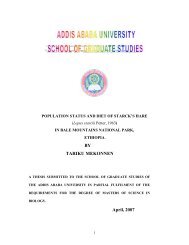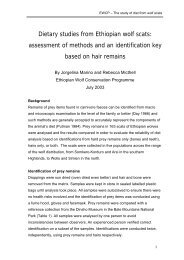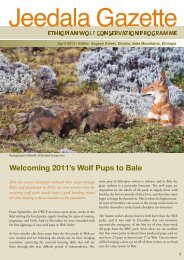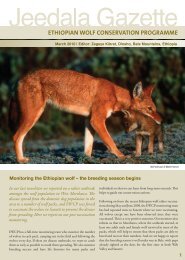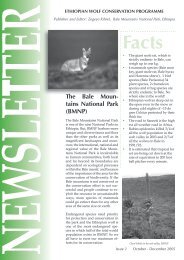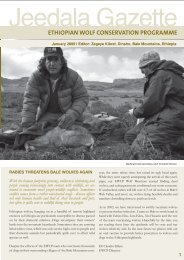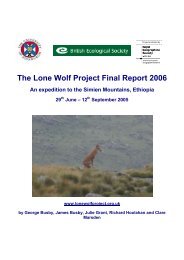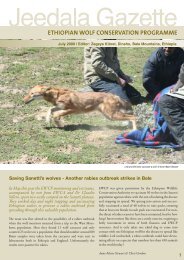Girma-Eshete-Jenbere-thesis - Ethiopian Wolf Conservation ...
Girma-Eshete-Jenbere-thesis - Ethiopian Wolf Conservation ...
Girma-Eshete-Jenbere-thesis - Ethiopian Wolf Conservation ...
Create successful ePaper yourself
Turn your PDF publications into a flip-book with our unique Google optimized e-Paper software.
Chapter V: Conclusion and Recommendations<br />
5.1. Conclusion<br />
This study was designed to develop an understanding of the existing community management and<br />
status of Mt. Abune Yoseph Afro-alpine ecosystem by taking <strong>Ethiopian</strong> wolf as a flagship species<br />
of the ecosystem. Accordingly, efforts have been made to explore socio-economic and natural<br />
resources assessment of the mountain for the improvement of user community livelihood, their<br />
perception towards its management and its endemic wild (<strong>Ethiopian</strong> wolf) as well as tried to show<br />
the human- livestock interference impact and the resulting conflict with wolf in the ecosystem.<br />
The methods employed, which consist of socio-economic interview, ecologic survey and discussions<br />
with key informants were useful in addressing the aims and leading to the following conclusions.<br />
The results of this study clearly showed Mt. Abune Yoseph Afro-alpine ecosystem provide essential<br />
ecosystem economic goods and services vitally important for the livelihoods of local communities<br />
within the limit of sustainability. Due to this fact, majority of the local community had positive<br />
perception towards the ecosystem and its flagship species the <strong>Ethiopian</strong> wolf. A good or positive<br />
perception towards communal Afro-alpine ecosystem helps to protect or conserve its resources<br />
from the increased human and livestock interference impact by designing sustainable ecosystem<br />
management together with community which can avoid the existing human-wildlife conflict<br />
particularly human-wolf conflict in the area.<br />
Currently, tremendous pressure of the swelling human and livestock population expressed<br />
through unsustainable resource exploitation from the ecosystem in the form of long time grazing,<br />
frequent firewood collection and agricultural encroachment leads to erosion, gulley formation<br />
66



